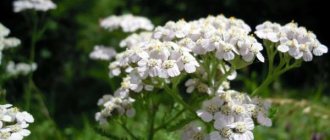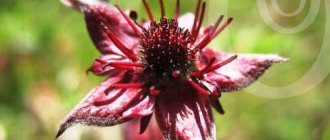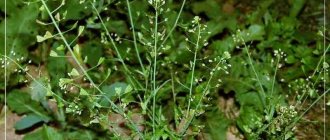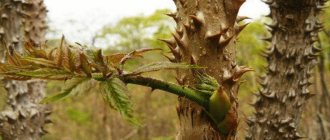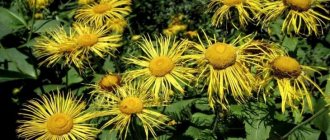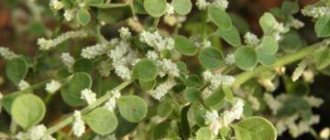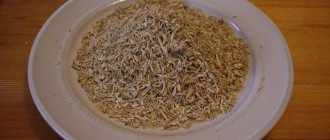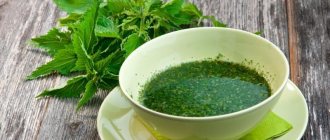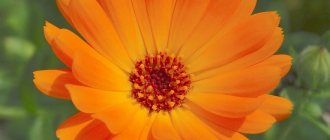Yarrow is a unique medicinal herb. It has many beneficial properties that help cope with serious diseases.
Yarrow is shrouded in a large number of legends and fables. Its Latin name, Achillea
millefolium,
translates to
Achilles' thousand . According to Greek myths, Achilles was hardy, strong and brave in battle, and his many wounds were healed thanks to an inconspicuous grass with numerous petals. Historians say that the Russian commander Alexander Suvorov ordered his soldiers to carry with them a canvas bag with powder from the yarrow herb.
Read an article on our website about the best antiviral, antifungal and immunity-boosting herbs and herbal infusions. The recipes presented will help with the flu, acute respiratory infections, bronchitis, gastrointestinal diseases and other ailments.
In folk medicine it is called “cutting agent”, noting its beneficial properties - stopping bleeding, healing wounds, cuts. What other benefits of this herb are, as well as about contraindications and a description of yarrow, read in this article below.
Yarrow: interesting facts
Yarrow
Interesting facts about yarrow, such an inconspicuous plant, are additional confirmation that people have used the healing herb since ancient times:
- Neanderthals. The medicinal properties of the plant were first discovered by the distant ancestors of humans. Archaeologists have discovered seeds and dry leaves of herbal medicine at Neanderthal sites.
- Ancient Greece. The Greeks used the plant to heal wounds, protect against fever, and improve blood circulation. In addition, a decoction of yarrow leaves was popular as an antipyretic, helping with digestive problems.
- China. Residents of this country successfully treated not only the body with the help of the plant, but also claimed that an infusion from the leaves strengthens the mind and gives energy to the body.
- Medieval Europe. Doctors used the plant as a hemostatic medicine. Witches actively used it to strengthen their spells. Brewers added it to add flavor to the foamy drink.
- America. Indian healers treated their wounds and infections. In addition, yarrow was popular for earaches and as a sedative.
- In the 17th century, its nutritional products were discovered . European chefs add this herb to stews and prepare purees and soups with it.
- Interesting and unusual "folk" names for yarrow in other countries : protector from bleeding, old man's pepper, war herb, wort for wounds, carpenter's weed.
- The chronicles of Ancient Russia describe that the grandson of Dmitry Donorsky was treated for frequent nosebleeds with a decoction of yarrow leaves.
- Today, the plant is widely used in folk medicine, gardening, cooking, and cosmetology.
In folklore, the plant is associated with a warrior - it grows everywhere, despite the weather and natural conditions. In Ukraine, it was woven into wreaths; in the language of “flowers,” it meant “disobedience , “perseverance .
Where else is yarrow used?
Oddly enough, the plant, despite its bitter taste, is suitable for use in cooking:
- young leaves are finely chopped and added to soft cheese, salads, soups and meat dishes;
- dried leaves and flowers are used to flavor table wines, liqueurs, tinctures and kvass;
- ground dried flowers and leaves are sifted through a sieve, and the resulting powder is used as a seasoning, which has a pleasant aroma and promotes digestion.
In all these culinary fantasies, the main thing is not to overdo it, since excess herbs in dishes can cause symptoms of poisoning in the form of a rash and dizziness.
Another surprising fact for me personally is yarrow flowers in landscape design.
It turns out that there are a large number of varieties and hybrids bred specifically to create colorful compositions in gardens, parks and rock gardens. Since yarrow is unpretentious, multiplies quickly, blooms for a long time and does not require painstaking care, designers are happy to decorate flower beds and lawns with its yellow, purple, ruby, lilac and beige flowers.
Yarrow plant: description
Yarrow plant
Yarrow is a herbaceous perennial plant of the Asteraceae . Externally, it is easily recognized by its long stems. They contain a large number of small dark green leaves, collected in a herringbone pattern. The plant blooms in small, white or pink inflorescences collected in the form of brushes. Yarrow grows in meadows, along roads, fences, so it is often considered a weed plant. The slightly pungent smell can be confused with chrysanthemum. Here is another description of this herb:
- Yarrow has a thick, branched rhizome, growing in breadth with numerous thin roots.
- Erect, long stems reach a height of up to a meter.
- Small, linear leaves are dissected into small segments.
- Inflorescences of small flowers are formed in the form of numerous baskets located on the tops of the shoots.
- The flowers located in the middle are bisexual, while those on the edges are female.
- Yarrow is a honey plant and blooms throughout the summer. The seeds of the plant ripen in August-September.
The plant species is widespread in Europe, Asia, and grows everywhere throughout the European part of Russia, the Caucasus, and Siberia.
Appearance
Photo: Pixabay
Yarrow is difficult to confuse with other plants. This is a Eurasian species that has been introduced to other continents. It is found almost throughout the entire territory of Russia, with the exception of the northernmost regions.
The plant is a perennial and can reach a height of 20 to 80 centimeters. It has a long, cord-like creeping rhizome.
The leaves are pinnate, pubescent with a large number of small thin cilia, which give the plant its name. The stem at the top bears an inflorescence - a shield with small flower baskets. Each basket consists of 5-7 marginal flowers with white or pink tongues and several central tubular ones.
This inconspicuous plant is considered a good honey plant. It blooms for a long time, flowering begins in June and ends in late autumn in September - October.
Yarrow grass: collection and preparation
Herb yarrow
In folk medicine, only the outer parts of yarrow are used - grass, inflorescences. The grass is harvested during the flowering period of the plant, from June to September. up to 15 centimeters long, with a knife or pruning shears , capturing no more than five leaves. You can only collect the leaves of the plant, without the stems. In this case, only large, developed ones are collected, leaving the denser basal leaves intact on the stem.
The collection and preparation of inflorescences is carried out in the summer, during the flowering of yarrow:
- The flower baskets are cut, taking the stem of the plant - about four centimeters.
- The stems are dried in small bunches. Each of them should contain no more than 6-8 branches of yarrow.
- Small bundles are also made from the leaves of the plant. It is important to remember that the smaller its volume, the faster the collection will dry.
- All bundles are tightly tied with thread and hung horizontally in a dry, ventilated place. The distance between them should be at least 10 cm.
- The drying time depends on the room temperature and humidity.
The inflorescences of the plant are laid out on paper, parchment or a tray in one thin layer, then dried in a dry, ventilated room, avoiding direct sunlight. For uniform drying, the collection is carefully turned over several times during drying.
The drying process in all cases takes about 4-5 days. Next, the resulting raw materials are placed in glass containers and hermetically sealed. Dry yarrow can also be stored in fabric bags and cardboard boxes. Shelf life – 1 year .
What it looks like and what it consists of
Common yarrow is the most common species, which is found on almost all continents, is unpretentious, grows on the edges and clearings, fields and meadows, in steppes and ravines, along roads and near human habitation.
It blooms throughout the summer with small white or pale pink flowers, collected in umbrella inflorescences on the branched tops of the stems. The leaves are elongated, dissected into many small segments, which is what gave the yarrow its name.
During the flowering period, the plant accumulates the maximum amount of valuable substances, including:
- essential and fatty oils;
- organic compounds Achillin, caryophyllene, azulene;
- coumarins;
- inulin;
- esters;
- camphor;
- tannins and bitter substances;
- organic acids;
- mineral salts of magnesium, potassium, calcium;
- vitamins A, C and K.
These components give the plant the opportunity to demonstrate its best abilities to heal various ailments. For the sake of its medicinal properties and rich chemical composition, ancient healers prepared it for future use, knowing exactly when to collect yarrow and how to do it in the most nature-friendly way, and modern herbalists preserve and continue centuries-old traditions.
Medicinal yarrow: chemical composition
Medicinal yarrow
This plant is very useful for various diseases. Its chemical composition is valued in traditional medicine. This plant is used to make drugs for the treatment of many serious pathologies. The leaves of the medicinal herb yarrow contain:
- Carotene , which has a positive effect on skin regeneration and tissue growth.
- Alkaloids , including Achilleon, which help blood clot.
- Silicon promotes rapid healing of wounds and burns.
- Tannins have a bactericidal effect, helping in the fight against inflammatory processes.
- Vitamins C, K - help strengthen vascular tissues and blood clotting.
- Resins have an antimicrobial effect.
- Essential oils, chamazulene - have an antispasmodic and antimicrobial effect on the body.
- Ascorbic acid helps improve immunity.
The benefits of such herbs are known not only to traditional healers, but also to doctors. Read more below.
Compound
The herb contains:
- essential oil containing a large amount of chamazulene,
- esters,
- camphor,
- glycosides (luteolin and apigenin),
- tannins,
- alkaloid achillein,
- borneol,
- thujone,
- organic acids,
- cineole,
- carotene,
- resins,
- vitamins K, C,
- bitterness.
Rich in mineral content:
- magnesium,
- potassium,
- boron,
- zinc,
- calcium,
- selenium,
- copper,
- molybdenum.
The flavonoids present in it may have beneficial effects on the intestines. They will relieve spasms and reduce the formation of gases.
Achillesin, which the herb contains, will increase appetite. It irritates the taste buds. For this reason, yarrow is recommended for children with poor appetite. It is prepared as a decoction and a little honey is added to it to mask the slight bitterness.
The plant is used as a hemostatic agent because it contains choline. In this case, blood clots do not form. This is especially highly valued, since it allows the plant to be used even during heart attacks and strokes. Thrombophlebitis will also not be an obstacle to taking yarrow.
The anti-inflammatory effect of the herb is due to the presence of tanning components and essential oils. In this regard, yarrow is indispensable for the treatment of atopic and allergic dermatitis, helps with burns and suppuration of wounds.
Doctors recommend it as a sedative and sedative.
Yarrow plant: beneficial properties for the body of men and women
Yarrow plant
The varied medicinal properties of yarrow are explained by a large complex of substances contained in the plant. In addition to its main purpose - hemostatic properties, it has a beneficial effect on the male and female body, bringing benefits in completely different cases. Due to its positive effect on the nervous system, it helps restore erectile function. The plant promotes the production of testosterone, increasing male potency and sexual desire. Here are some other beneficial properties for the body of men and women:
- The yarrow plant is prescribed for men engaged in heavy physical activity.
- A decoction of the plant has a general strengthening effect, an immunostimulating effect, and has a positive effect on the genitourinary system and gastrointestinal tract.
- For the female body, yarrow is an indispensable herb. One of its popular names is “tree” or “women’s herb”, which effectively treats women’s ailments.
- The plant is also useful for problems with lactation.
- Yarrow helps with acne, hair loss, and as a mild sedative.
The benefits of taking yarrow are very extensive; it is enough to list only the main medicinal properties of the plant:
- The plant helps to quickly heal wounds and stop bleeding.
- Yarrow has an antimicrobial effect.
- The microelements included in the composition help strengthen the nail plate and preserve vision.
- The plant has an anti-inflammatory effect, acting on the body as a natural antiseptic. This allows its solution to treat burns, wounds, and abrasions.
- Promotes strong sweating, helping to cope with fever and high temperature.
- Taking the decoction is useful for intestinal diseases, gastritis, colitis. Tannins have astringent properties and are essential for diarrhea.
The herb has an antiallergic and diuretic effect. By accelerating metabolism, it helps normalize body weight.
Medicinal properties
Let's find out exactly what properties of yarrow give it the right to be considered one of the most popular medicinal herbs.
- The plant's worldwide popularity comes primarily from its ability to stop external and internal bleeding, which it possesses thanks to Achillinus. This property is widely used in gynecology, gastroenterology and proctology.
- The next important therapeutic quality is the ability to improve the condition of the circulatory system, dilate blood vessels and increase their elasticity, reduce the frequency of contractions of the heart muscle and stabilize blood pressure.
- The anti-inflammatory and astringent properties of the plant have a beneficial effect on the mucous membrane of the gastrointestinal tract and are successfully used in the treatment of ulcers, gastritis, hemorrhoids, and colitis.
- Diuretic and antispasmodic properties are used in the prevention of edema and treatment of urolithiasis and cystitis.
- The antihistamine effect of yarrow allows it to be used in the treatment of allergic reactions, including in people suffering from bronchial asthma.
In addition to the listed properties of the plant, which are common to the human body, there are others that help to cope specifically with women’s, men’s or children’s ailments.
Benefits of the plant for women's health
A decoction of yarrow, prepared in the traditional way, which I will talk about a little later, works effectively in complex therapy for the following problems typical for women:
- heavy, painful menstruation;
- postpartum and other uterine bleeding;
- inflammatory diseases of the mucous membrane of the vagina and cervical canal;
- cervical erosion;
- endometriosis, fibroids;
- phlebeurysm;
- postpartum and age-related urinary incontinence;
- osteoporosis;
- menopause
It is worth noting that long-term use of yarrow-based drugs can lead to a delay in menstruation, so during the treatment process it is necessary to take breaks for at least a month.
The use of medicines containing yarrow during pregnancy is strictly contraindicated. This herb has some toxicity, which can negatively affect the formation and development of the fetus.
In the early stages there is even a risk of miscarriage, and in later stages there is a risk of premature birth. To eliminate all risks, expectant mothers should limit themselves to products for external use, after consulting with a doctor.
Is there any benefit for men?
Yarrow does not have any specific effect on the male body, but this does not mean that the plant is useless for men. General strengthening properties, as well as a beneficial effect on the cardiovascular system, definitely contribute to the healing of the male body, especially upon reaching adulthood.
For men who are prone to premature hair loss, we can recommend rinsing with a decoction and compresses with yarrow oil. According to the observations of herbalists, these remedies stimulate hair growth and prevent hair loss.
The influence of the plant on the children's body
Decoctions and infusions are widely used in pediatrics. Starting from the age of three, they can be taken orally, and baths are perfect for younger children. Yarrow helps:
- increase sweating and relieve chills and fever;
- restore strength and appetite after illness;
- reduce skin itching due to rubella and measles;
- alleviate the course of hay fever and bronchial asthma;
- disinfect the mucous membrane of the throat and oral cavity for tonsillitis, laryngitis, pharyngitis, stomatitis;
- treat blepharitis, conjunctivitis and other eye diseases;
- cope with childhood enuresis.
The only drawback of yarrow preparations for oral administration is the bitter taste, so it is better to sweeten them with honey or stevia.
Yarrow: beneficial properties and use in gynecology
Yarrow
The effectiveness of the plant against female ailments is beyond doubt. Decoctions, infusions, douchings have been used in folk medicine since ancient times and are useful for:
- Heavy menstrual cycle
- Healing of cervical erosion, resorption of fibrous formations
- Uterine bleeding
- Cystitis
Yarrow has a powerful effect on chronic forms of diseases, so it is actively used in gynecology. It is also worth noting such beneficial properties of the plant as increasing the effectiveness of the used medicinal devices several times.
Medicinal herb yarrow: contraindications for the body of women and men, special instructions
The medicinal herb yarrow is contraindicated for pregnant women.
Before using medicinal herbs, it is necessary to remember that all plants have a toxic effect to varying degrees. Therefore, independent use requires caution. The course of administration should not be long, without exceeding the dosage specified in the instructions. The medicinal herb yarrow has contraindications for the body of women and men. Please read the special instructions below so you know them by heart.
You should avoid taking yarrow:
- Pregnant women
- In case of individual intolerance to components
- Hypotension - people with low blood pressure
- Tendency to form blood clots, increased blood clotting
Also, when taking yarrow, there may be side effects caused by long-term consumption - dizziness and skin rashes. If any reaction occurs, treatment should be stopped immediately and consult a doctor for advice.
Yarrow side effects, contraindications
Yarrow tea provides you with a number of benefits and is considered safe when taken in recommended dosages; However, you should be aware of situations where this tea may not be desirable for you.
Possible side effects
There are people who experience contact dermatitis when using fresh leaves. Therefore, if you begin to feel any form of skin irritation, it is best to stop contact with yarrow leaves.
There is also a possibility that you may experience drowsiness and increased urination while taking this tea. Therefore, it is necessary to consult a doctor and find out contraindications. Find out if this herb is safe for you.
Taking too much yarrow tea is contraindicated
Even if you don't experience any skin sensitivity at first, drinking too much tea over long periods can cause side effects. Which will lead to skin allergies or sensitivity to sunlight.
Drinking too much yarrow tea can also cause dizziness and headaches. Stop taking the tea immediately if you experience any of these symptoms, and if they do not subside, contact your doctor as soon as possible.
The herb is not considered toxic, although it does contain small amounts of thujone, a substance known to be harmful to the liver. This is why it is important to stick to the recommended dosages. Consult with a professional to determine the right amount of herbal tea for you.
When to Avoid This Tea
If you are pregnant, then drinking yarrow tea is unsafe due to existing contraindications. This herbal tea is known to stimulate the uterus and menstrual cycle, which can lead to fetal malformations or even dangerous miscarriage.
If you are breastfeeding, drinking this tea may not be a good idea as its chemicals can pass into breast milk and harm your baby. There is not enough research yet to be sure that this herb is safe for breastfeeding.
As your child gets older, you may be tempted to give him yarrow tea. It is not recommended to give it until the child is 5 years old. Even then, talk to your pediatrician. He will find a safe dosage according to your baby's size and needs.
Contraindications for the face if you have serious gastrointestinal ulcers. It is best to avoid this tea, as yarrow's stimulating effect on digestive juices can cause unnecessary pain and discomfort.
Yarrow belongs to the same family as ragweed, chrysanthemums, marigolds, and daisies. So if you are allergic to one of these herbs, there is a good chance that you may be allergic to yarrow. Be aware of contraindications and avoid herbal tea as it can cause a serious allergic reaction.
Yarrow contraindications for joint use
Yarrow is known to interact with blood thinners, lithium, stomach acid reducers, sedatives, blood pressure and epilepsy medications. Contraindications do exist as this tea may seriously increase or decrease the effectiveness of your medication. You should consult your doctor before drinking this herbal tea for medicinal purposes.
The use of decoctions and tinctures may increase the risk of bleeding. It is best to avoid it if you suffer from a bleeding disorder or are taking blood thinners. You should also stop taking this tea if you are 2 weeks away from surgery.
Yarrow: beneficial properties and use for pyelonephritis
Yarrow: beneficial properties and use for pyelonephritis
Yarrow has an anti-inflammatory, hemostatic effect. Therefore, the herb helps treatment, especially if the disease is accompanied by additional symptoms - hematuria and cystitis. In this case, yarrow is taken both as an independent decoction and as part of herbal preparations. The beneficial properties of this plant for kidney diseases cannot be underestimated:
- Treatment of pyelonephritis with folk remedies alleviates the symptoms of the disease, eliminates foci of inflammation, preventing the disease from becoming chronic.
- But it is important to understand that the effectiveness of treatment is achieved only in combination with medications.
- Numerous medical studies prove the effectiveness of using yarrow together with uroseptics and antibacterial drugs.
- With the right, rational approach, herbal medicine helps to cope with any kidney diseases in a shorter time, including preventing complete anuria, which is characteristic of pyelonephritis.
Here are the applications in kidney treatment:
- To prepare the decoction you need 1 tbsp. pour a spoonful of herbs into 250 ml. boiling water
- Infuse the drink for at least 15 minutes .
- Take throughout the day in small portions.
Important: Despite the fact that this is a herb, it has contraindications. Therefore, before starting treatment, consult your doctor.
Decoction, infusion and tincture of yarrow
Yarrow decoction. Decoctions of the plant help get rid of diseases such as bronchial asthma, colds and skin diseases, and severe headaches. A decoction of yarrow in water is used to treat kidney and kidney stone diseases. In addition, heart and stomach diseases were and are treated with the decoction; it is used as an expectorant.
To prepare the decoction, the crushed herb is placed in a glass or enamel container, poured with cold water and allowed to brew for several hours. The mixture is boiled in a sealed container over low heat for about 20–30 minutes, stirring frequently, then filtered and squeezed through cheesecloth.
Infusion of yarrow.
The herb in the form of an infusion is used for catarrh of the respiratory tract, as a means of improving appetite and digestion, to increase the amount of milk in a nursing mother and for menstrual irregularities. The infusion gives excellent results in gynecological practice for inflammatory processes. In addition, it is used for rinsing during inflammatory processes in the oral cavity, and is also used in enemas for hemorrhoids.
Recipe.
For 200 mg of water at room temperature, add 15 g of finely chopped herbs. The container with the mixture should be placed in a boiling water bath and left with the lid closed for 15 minutes, stirring constantly. After 15 minutes, the pan must be removed from the stove and cooled at room temperature for at least 45 minutes, then strain the product and add water to the original volume. It is recommended to take the infusion warm, one tablespoon 3-4 times a day. The medicine should be stored in a cool place at a temperature of no more than +10 °C.
Yarrow tincture.
Alcohol tincture of yarrow is prepared with 40% alcohol from dried or fresh raw materials in a ratio of 5:1. A mixture of leaves, stems and flowers of the plant is used as raw material. Typically, the tincture is used as an anti-inflammatory and analgesic, as well as for healing wounds and bruises. Externally, the tincture is used to impregnate wound dressings. For pulmonary bleeding and diseases of the gastrointestinal tract, the tincture is taken orally, 40–50 drops 3 times a day.
Herb yarrow and St. John's wort: what does the collection help with?
Herb yarrow and St. John's wort Medicinal
herbs yarrow and St. John's wort are among the most popular among lovers of herbal medicine. They have almost identical medicinal properties, having a similar effect on the human body. Therefore, they are very rarely combined into a general collection. One of the options for using two herbs together is to fight extra pounds.
The infusion is prepared as follows:
- Take 20 grams . each of the herbs.
- Pour 1.5 liters of boiling water .
- Next, the broth must be left for two hours.
- Strain the resulting liquid.
- You need to drink the infusion throughout the day.
A mixture of herbs gives the body a feeling of fullness and satisfies hunger. In addition, the decoction has a diuretic and choleretic effect, which are also important in the process of weight loss. A tincture from a collection of medicinal herbs helps normalize liver function and improves metabolism.
What else does collecting help?
- Yarrow and St. John's wort help expand the bile ducts and normalize blood circulation.
- Very often, both plants are used in the treatment of the urinary system.
To do this, do the following:
- Take a tablespoon of each herb and pour a glass of boiling water.
- Leave for several hours in a warm place or thermos.
- Take throughout the day.
You can drink these herbs in the form of tea. At the pharmacy you can buy this collection in paper filter bags. Just pour boiling water over 1 bag and leave for a few minutes – the tea is ready.
Procurement of raw materials
There is no shortage of raw materials for this medicinal plant, but you can stock up on the herb for future use. The grass lends itself well to harvesting. But there are still little tricks.
It is advisable to cut shoots in the middle of their height or just the tips of the shoots during flowering. The lower part of the plant is very rough, and its healing qualities are low.
Do not try to pluck shoots with your hands or break them off. This is unlikely to be possible: the stems of the plant are so strong that it is more likely to pull the plant out by the roots than to tear off the upper part of the shoot.
You can’t get high-quality raw materials without a knife. Cut shoots should be tied into bunches and hung to dry in the attic, barn, or under a canopy. The grass should only be dried in the shade; in good weather it dries in ten days. Readiness can be checked by the degree of fragility of the stems
The shelf life of dry raw materials in a closed glass container is no more than two years. But healers advise not to store raw materials for a long time, but to prepare them annually.
Yarrow: beneficial properties and contraindications for children
Yarrow: beneficial properties
The plant has contraindications, so it can only be used with the permission of the attending physician. Children should not start treatment without consulting a pediatrician. A doctor may allow a child to be given decoctions with this herb, but not earlier than 6 years of age.
Here are the beneficial properties of yarrow for children:
- Infusions and weak decoctions have a positive effect in the treatment of respiratory diseases, help with tonsillitis and sinusitis.
- To prepare, brew 1 tablespoon of with 2 cups of boiling water.
- Leave for about 30 minutes and give to your child as an additional drink throughout the day.
- Add honey to improve taste.
Tea from the collection of yarrow and chamomile is an effective remedy for allergies. For skin rashes and rubella, baths with yarrow herb help well. The decoction is prepared as follows:
- Brew 100 gr. leaves with 2 liters of water .
- Simmer over low heat for 30 minutes .
- Strain and pour into the bath.
To enhance the effect, chamomile and celandine are added. In this case, all the herbs need to be mixed and also take 100 grams of the mixture.
Contraindications
Photo: Pixabay
As such, there are no contraindications to taking plant-based medications. However, internal use of the plant requires caution.
With prolonged use and taking large doses of yarrow preparations, unpleasant consequences are possible. Nausea, dizziness and skin rashes may occur.
Yarrow - use in folk medicine, treatment: tea, tincture, herbal preparations
Yarrow - use in folk medicine
To extract the maximum healing properties from yarrow, you need to know the rules for its preparation. Here are the uses in folk medicine for treatment:
Tincture
- The base consists of alcohol or vodka.
- Required proportions: 100 ml. Combine the liquid with 5 tablespoons of yarrow.
- Stir, place in a dark place for 10 days .
- The tincture is used internally for bleeding, cholecystitis, hepatitis, and helps in the treatment of kidney disease and cystitis.
- It is also effective for treating abrasions, wounds, and combating acne.
Tea
- Basic brewing recipe: 2 teaspoons of herbs with a glass of boiling water.
- Cover the cup and let sit for 15 minutes .
- Tea is used for weight loss and intestinal infections.
Decoction
- Pour a teaspoon of yarrow into a glass of boiled water.
- Boil for 5-10 minutes over low heat. Take throughout the day.
- The decoction helps with exacerbation of hemorrhoids.
- It has a diuretic effect, therefore it is effective for edema and hyperthermia.
- Used in the treatment of diseases associated with the gastrointestinal tract during exacerbation of gastritis.
- The product is used for insomnia, stress, anxiety, and neuralgia.
Herbal infusions - a plant used in combination with other medicinal herbs, is a common and effective way to treat a large number of diseases:
- Yarrow with chamomile is recommended for use as a decoction for acne and as a wound healing agent. The infusion is effective for pain and stomach cramps.
- Yarrow and nettle are used for painful menstruation.
- Yarrow with celandine is used for inflammation of the kidneys and bladder.
- Yarrow and mint are consumed for gastritis. Mint has a calming effect, so the infusion is drunk for gastrointestinal spasms and inflammatory diseases of the stomach.
- Yarrow with calendula helps with ulcers of the stomach and duodenum. This collection is effective for infectious diseases, gastritis.
- A collection of plantain, chamomile, yarrow, and St. John's wort helps stop bleeding.
- Yarrow and wormwood are used to improve appetite.
These folk remedies are very effective and will definitely help. But before use, you should consult a doctor.
How to brew yarrow tea
It's time to get into the kitchen and learn how to brew yarrow tea. Here is a quick and easy recipe that is most commonly used. Also some tips on how to improve it.
- Parts used:
aerial parts - leaves, flowers and stems - fresh or dried. - Quantity:
1 teaspoon (dried) / 1 tablespoon or 2-3 leaves (fresh). - Water temperature:
boiling (
100ºC
). - Exposure time:
10 minutes. - Dosage:
3 cups per day. - Blend with:
honey, lemon, elderberry, mint, mullen, eucalyptus, chamomile
Yarrow tea is made using the above-ground parts of the plant, such as flowers, leaves and stems. They can be used dried or fresh to prepare an infusion. Some recipes also use the powdered form.
Let's start:
- Place 1 teaspoon of dried yarrow in a teapot over a cup of tea. Alternatively, you can use 1 tablespoon of chopped fresh leaves or 2-3 whole leaves.
- Bring water to a boil (100ºC) and pour into the kettle.
- Let the tea steep for 10 minutes. The longer the tea steeps, the stronger the flavor will be, but if it sits too long, it may become too bitter to drink.
- Strain the tea into a cup and then add a slice of lemon and a teaspoon of honey to sweeten your herbal tea and get rid of its bitter taste. The tea is said to taste similar to tarragon.
- Drink hot, especially when treating a cold and relieving a fever.
- You can drink up to 3 cups of yarrow tea per day, but not more than 2 weeks. Long-term use is not recommended.
Additional Tips
Yarrow tea goes well with other herbs. Some of them can be used to improve the taste. And also to enhance the beneficial effects of herbal teas. For example, yarrow and eucalyptus can be mixed, and when you inhale the steam from this infusion, it can help clear sinuses and congestion.
Yarrow tea with mint and elderberry is an excellent mixture to drink. Especially when you have the flu or a cold with a fever. Mint not only improves the taste of yarrow, but, like elderberry, strengthens the immune system. Together they fight the first symptoms if you get sick. You can also try mixing chamomile.
Yarrow and sesame tea is a mixture that you can drink if you suffer from lung problems and have a cough.
Yarrow tea can be used to create healing herbal baths. This may help relieve skin irritations, but be sure to test a small area of skin for allergies first. A foot bath is beneficial for children and adults. When using this tea topically, be sure to let it cool before applying to your skin.
Have you had any luck growing yarrow in your garden? Only use it if it has not been exposed to chemicals. Collect yarrow in bloom. Then let it dry by hanging it upside down in a warm, dry place. Be sure to store yarrow in an airtight container. This way you can preserve it for a long period of time.
Yarrow herb - beneficial properties and contraindications: reviews
Yarrow herb - beneficial properties and contraindications
The beneficial properties of yarrow herb and its contraindications were described above. It suits some people, and people treat many ailments with this herb. Others are prohibited from using it. Read reviews from other people who have found this herb helpful. They took it in different forms: tea, decoction, tincture, etc.
Valery, 55 years old
Cured gastritis with yarrow. I picked the leaves and dried them in a cool place. I brewed it as strong tea and drank it all day. I haven’t had this sore for 20 years now, now I drink tea sometimes as a preventive measure. Each brother prepares the stems and flowers of this plant. When I come to visit him, we also drink it like tea. He adds more chamomile and mint. For pain in the intestines, brew a stronger decoction and drink it for 4-5 days in a row. Thanks to nature for this flower.
Mira, 37 years old
In my youth, I vacationed with my grandmother in the village and helped her with housework. She chopped the flesh of her finger with an ax. Grandmother picked yarrow, cut it, and tied it with a bandage to the wound. I changed the bandage every day - morning and evening. The bleeding stopped almost immediately, and after a few days the wound “closed” itself.
Irina, 43 years old
In Russia, almost every herb is a storehouse of nutrients. It is better to drink infusions and decoctions with herbs than to take “chemicals” from the pharmacy. Yarrow is a savior for many women, especially after 40 years. When gynecological problems appear, the blood vessels become mischievous and the stomach suffers. I advised many of my friends to take yarrow tincture, it really helps.
Growing yarrow
The plant is not whimsical; it grows calmly in both sun and partial shade. Yarrow propagates vegetatively and by seeds. The seeds of the plant are sown in spring or autumn; the seeds are sown in beds or in a flower bed. In April, you can sow seeds for seedlings in pots. The plant's seedlings are very small, so they can easily be confused with a simple weed. The grass is propagated by dividing the rhizomes in the spring, and in the summer the plant can be propagated by green cuttings. Yarrow grows in one place for 5 years. When 5 years have passed, the plant needs to be transplanted to another place. To do this, the grass is dug up along with the roots, the weeds are removed, the bushes are divided and planted separately. When autumn comes, the bush must be cut off, leaving shoots that are at least 12 cm long.
Fertilizers must be added to the soil three times a month. Fertilizers are applied the first time before the plant blooms, the second time during the flowering period, and the last time after the plant blooms.
